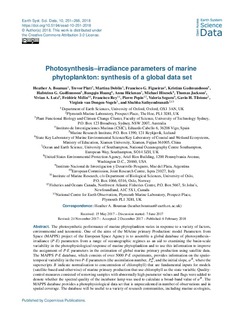Photosynthesis-irradiance parameters of marine phytoplankton: Synthesis of a global data set
Bouman, Heather A.; Platt, Trevor; Doblin, Martina; Figueiras, Francisco G; Gudmundsson, Kristinn; Gudfinnsson, Hafsteinn G.; Huang, Bangqin; Hickman, Anna; Hiscock, Michael; Jackson, Thomas; Lutz, Vivian A.; Mélin, Frédéric; Rey, Francisco; Pepin, Pierre; Segura, Valeria; Tilstone, Gavin H.; Van Dongen-Vogels, Virginie; Sathyendranath, Shubha
Journal article, Peer reviewed
Published version
Permanent lenke
http://hdl.handle.net/11250/2581337Utgivelsesdato
2018Metadata
Vis full innførselSamlinger
- Articles [3012]
- Publikasjoner fra CRIStin [3070]
Sammendrag
The photosynthetic performance of marine phytoplankton varies in response to a variety of factors, environmental and taxonomic. One of the aims of the MArine primary Production: model Parameters from Space (MAPPS) project of the European Space Agency is to assemble a global database of photosynthesis–irradiance (P-E) parameters from a range of oceanographic regimes as an aid to examining the basin-scale variability in the photophysiological response of marine phytoplankton and to use this information to improve the assignment of P-E parameters in the estimation of global marine primary production using satellite data. The MAPPS P-E database, which consists of over 5000 P-E experiments, provides information on the spatio-temporal variability in the two P-E parameters (the assimilation number, PmB, and the initial slope, αB, where the superscripts B indicate normalisation to concentration of chlorophyll) that are fundamental inputs for models (satellite-based and otherwise) of marine primary production that use chlorophyll as the state variable. Quality-control measures consisted of removing samples with abnormally high parameter values and flags were added to denote whether the spectral quality of the incubator lamp was used to calculate a broad-band value of αB. The MAPPS database provides a photophysiological data set that is unprecedented in number of observations and in spatial coverage. The database will be useful to a variety of research communities, including marine ecologists, biogeochemical modellers, remote-sensing scientists and algal physiologists.
